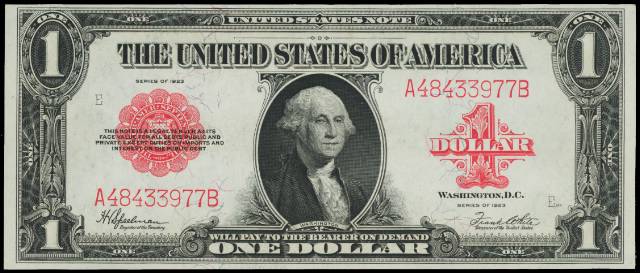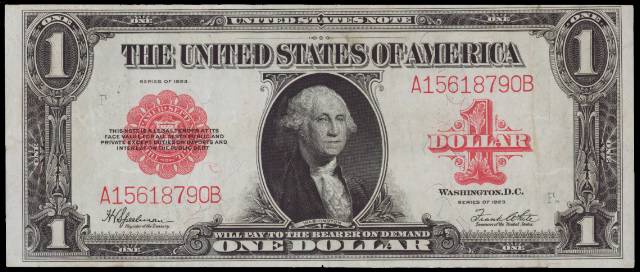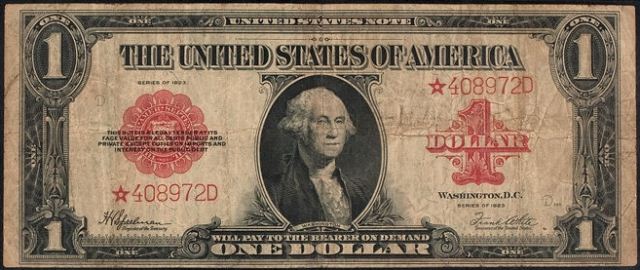Series of 1923 $1 Red Seal Legal Tender
History: The 1923 $1 legal tender note is the successor to the series of 1917 issues. Just like all other one dollar legal tender notes printed since 1869, the series of 1923 issue also has a portrait of George Washington it. The serial number and seal are both printed in red ink. This dollar bill is popular because it is another unique design and signature combination notes. All 1923 red seals were signed by Speelman and White. Based on that signature combination we know that these could have been printed as late as 1927, despite saying series of 1923.
Nickname: This is one of the few large size notes from the 20th century that does not have a well-known nickname. I guess some might call it a red seal horse blanket, but that is certainly not a well-used classifier. I have also heard the term cogwheel used on occasion. Most people just this a 1923 one dollar legal.
Other Facts: 1923 and 1928 one dollar bills are the only large size notes that were issued as both silver certificates and legal tender notes. It is always striking to see the blue seal silver certificate beside the red seal legal tender note. There are lots of low serial number 1923 $1 red seals known to exist. Serial numbers under 100 command premiums. However, I wouldn’t suggest paying much more than $100 extra for a three digit serial number. There is also a large run of uncirculated star notes known to exist from this series. Star notes are available in perfect condition starting at about $2,000.
Values and Grading: Generally speaking, these notes aren’t as popular as they were a few years ago. Easy access to high grade examples has made the demand lessen. What was once a $1,000 note can today be bought for around $600. As we mentioned above, low serial number notes are plentiful as are star notes. It is not uncommon to find 1923 $1 legal tender notes in superb gem condition. These are great as a type note, but they are probably not a great long term investment.
Choice Uncirculated or Better: Something in choice uncirculated condition is going to have absolutely no folds. And for the novice, no folds means that there are no old fold marks, being flat and in a holder today does not mean it is in perfect condition. Centering is the only difference between something worth $600 and something worth $2,000. There are hundreds, if not thousands, of uncirculated 1923 $1 red seals available to collectors.

This Uncirculated 1923 $1 Red Seal Is In Pristine Condition
Extremely Fine to About Uncirculated: We don’t usually picture an XF or AU note with our guides. The small imperfections that make something XF or AU like light folds and bends are not captured by scanning a note. However, we can tell you that 1923 $1 red seals in XF condition are selling for high $200s, and AUs are worth a little bit more than $400.
Very Fine: Very fine is often considered a “collector” grade. It allows you to get a lot of the eye appeal of a higher grade note, but without the price tag. The note pictured below has a few very faint white folds lines. An old rule of thumb is that if you think you see a fold line, it is a fold line.

The Folds on This VF Example Are Well Hidden But Still Present
Fine and Lower: We pictured a star note as our example of a 1923 $1 legal tender in fine condition. And the example shown is certainly towards the low end of the fine scale. You can see that the paper is dirty from years of use. The note would also be very soft without any crispness left. These notes are worth less than $100. They serve a purpose if you are looking to fill holes. However, our recommendation would be to just wait until a better example is available.

Even As A Star Note, This Bill Is Worth Less Than $1,000
Need an Appraisal or Offer? Don’t hesitate to contact us for any reason. We are always happy to help. Odds are that we know exactly what you 1923 $1 bill is worth and we are very likely buyers as well. Please send us an email: Sales@AntiqueMoney.com


